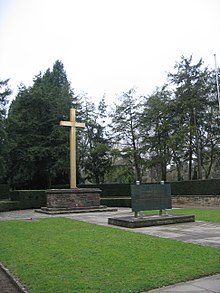North Cemetery (Bonn)
The municipal north cemetery in Bonn is located north of the city center, between the districts of Auerberg and Buschdorf . With a total area of 27 hectares, it is the largest cemetery in the federal city. The cemetery stands as a monument under monument protection .
history
The north cemetery was laid out from 1884 and initially served as a replacement for the old cemetery , which could no longer be expanded and therefore had to be closed for new burials at the end of the 19th century. The installation took place on today's Kölnstrasse , part of the Landstrasse on the left bank of the Rhine and the former Bundesstrasse 9 from Bonn to Cologne . Before the cemetery was set up, its property was used as a so-called Schindacker to dispose of animal carcasses, and there was a place of execution on part of today's cemetery grounds until the 1770s .
Originally, the north cemetery was called the new cemetery to differentiate it from the old cemetery . It was not given its current name until 1910 after the city of Bonn had laid out another large burial ground in Bonn with the southern cemetery in Dottendorf . In 1933, the municipal cemetery of honor in the north cemetery was redesigned and equipped with an 8 m high wooden cross.
Both the cemetery itself and its infrastructure have expanded over the decades. Initially only about eight hectares in size, the north cemetery grew to its present size in the 1940s and 1970s. The porter's building, some of which has been preserved to this day, is the oldest structure on the north cemetery: it existed before it was opened and originally served as a hunting lodge. In 1913 a chapel was built in the cemetery. From 1906 to 1961 there was a train station immediately south of the cemetery called the Nordfriedhof of the Cologne-Bonn Railways .
The entry of the north cemetery including the chapel in the list of monuments of the city of Bonn took place in 1985.
On April 25, 2017, Wu Wei Tse, Chairman of the Board of the Federation of Chinese in Germany , and City Planning Officer Helmut Wiesner signed a contract for the construction of a special burial ground for members of the Chinese ethnic group.
Memorial of the Federal Republic of Germany
During Bonn's time as the seat of government , the Hochkreuz, which belongs to the cemetery of honor on the north cemetery, was the central wreath-laying ceremony from 1933 from 1951 - with an interruption from 1964 to 1968 - as part of the official ceremonies for memorial day by representatives of the Volksbund Deutsche Kriegsgräberfürsorge and the state, which was accompanied by honorary formations of the Bundeswehr at least from the mid-1960s . From 1980 the Hochkreuz served as a memorial of the Federal Republic of Germany, with a memorial plaque moved here, on which numerous heads of state laid wreaths during their state visits. After reunification , it was replaced by the Neue Wache in Berlin as a memorial for the Federal Republic in 1993 .
The bronze commemorative plaque, created by the sculptor Kurt Schwippert , was inaugurated in June 1964 as the Federal Republic's first memorial on the steps of the Academic Art Museum on Hofgartenwiese . It was not until June 1980 that plans were made to move the plaque in front of the wooden cross on the north cemetery. As the first head of state, Valéry Giscard d'Estaing laid a wreath there on July 7, 1980 .
Well-known burial sites
Architecturally remarkable tombstones from the late 19th century can be found in the old part of the cemetery between the main entrance and the chapel. The fatally injured aviation pioneer Bruno Werntgen (1893–1913) is buried in an honorary grave in this area . In addition, the former Lord Mayor of Bonn Ludwig Rickert (1897–1963), the Persian actor Fereydun Farrochsad (1938–1992), the founders of the Young Theater Bonn , Helmut Tromm (1922–2007) and Heidi Scholz-Tromm (1941–1941) are in the north cemetery. 2005), the German documentary photographer Ernst Linderoth (1916–2016), and the founder of the Klais organ manufacturer , Johannes Klais (1852–1925), were buried.
Artists and their grave sculptures
(without claim of completeness)
- Georg Busch (1862–1943): Vollmar (bronze statue of the Madonna)
- Wilhelm Fassbinder (1858–1915): Linden trees (Christ statue made of marble)
- Carl M. Geiling (1874-1924)
- Parmentier (bronze relief, resurrection angel)
- Hannes (bronze relief, signed duplicate of the resurrection angel)
- Carl Hertel (around 1920): Keutmann (Madonna statue made of marble)
- Karl Menser (1872–1929): Banze (bronze relief)
- Heinrich Pohlmann (1839–1917): Brauell (bronze figure from a series production)
Individual evidence
- ↑ List of monuments of the city of Bonn (as of March 15, 2019), p. 32, number A 841
- ↑ a b Stephan Scholz: Displacement memorials: Topography of a German memory landscape , Schöningh, Paderborn 2015, ISBN 978-3-506-77264-0 , pp. 133, 326.
- ↑ General-Anzeiger , August 10, 1985, Bonn city edition, p. 4
- ↑ Alexandra Kaiser: From heroes and victims: a story of the day of national mourning (= campus historical studies , volume 56). Campus Verlag, Frankfurt / New York 2010, ISBN 978-3-593-39288-2 , pp. 299–307, 378. (also dissertation University of Tübingen, 2009)
- ↑ a b Simone Derix: Illustrated Politics: State visits to the Federal Republic of Germany 1949–1990 , Vandenhoeck & Ruprecht, Göttingen 2009, ISBN 978-3-525-37005-6 , p. 145. (also dissertation University of Cologne, 2006)
- ^ Josef Niesen : Kurt Schwippert , Portal Rhenish History ( Landschaftsverband Rheinland )
- ↑ General-Anzeiger Bonn , June 17, 1964
- ^ Goslarer Zeitung, November 8, 1980
Web links
Coordinates: 50 ° 45 ′ 14.6 " N , 7 ° 4 ′ 4.1" E


